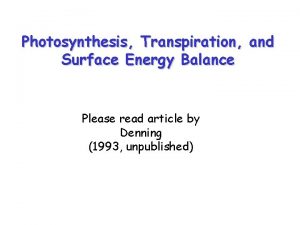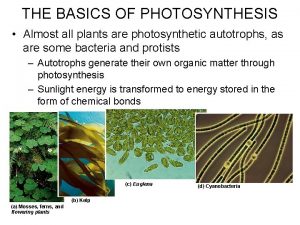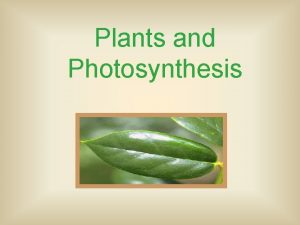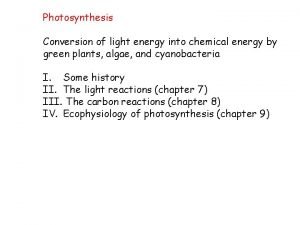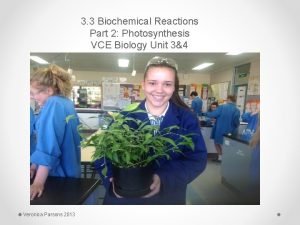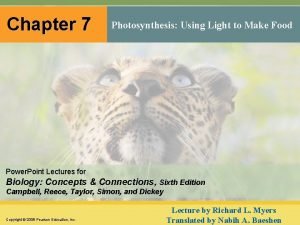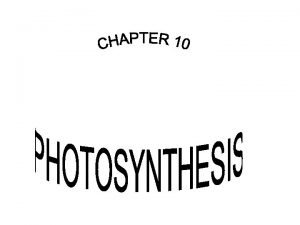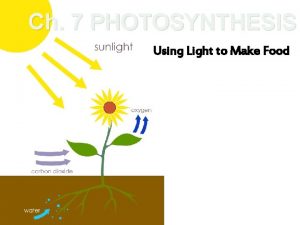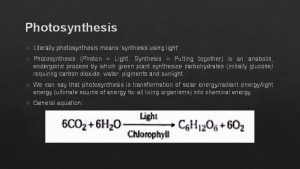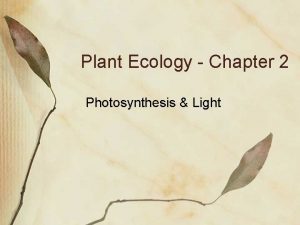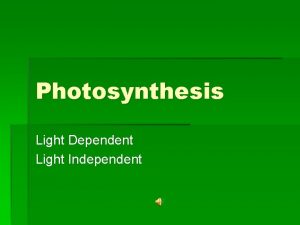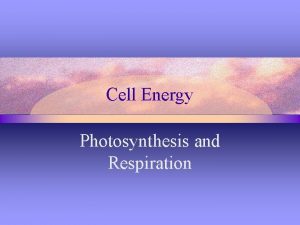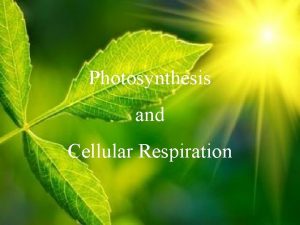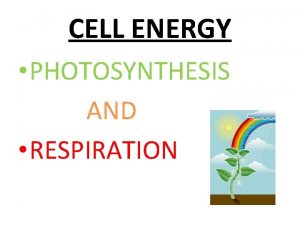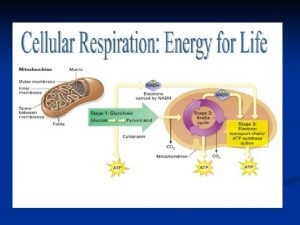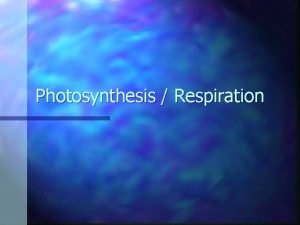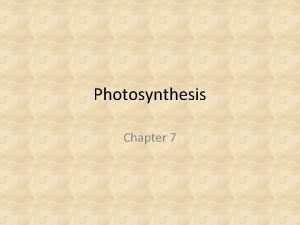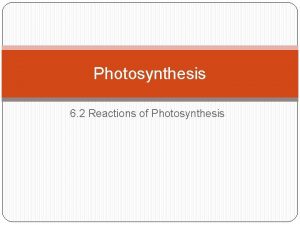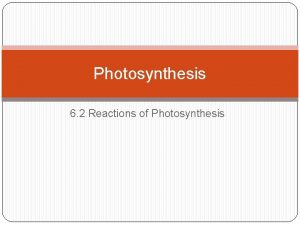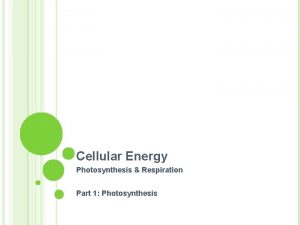Light and Photosynthesis 1 2 Light in the












































- Slides: 44

Light and Photosynthesis 1) 2) Light in the Ocean I) Intensity II) Color III) Inherent Optical Properties IV) Apparent Optical Properties V) Remote Sensing Photosynthesis I) Light Absorption II) Light Reactions III) Dark Reactions I need a work study student (library work, will pay) Oscar Schofield (oscar@ahab. rutgers. edu)


For satellite remote sensing the wavelength is the key to what you want to measure. c = l/u e = hu = hc/l



Figure 6

I) Light Irradiance Intensity 2500 mmol photons m-2 s-1 z 1 Z (meters) Ed 1 Dz 5. 0 mmol photons m-2 s-1 z 2 Ed 2 Lambert Beers Law Ed 2 = Ed 1 e-Dz*Kd 1) Because of Lambert Beers Law the ocean is dim 2) Plant life is dependent on light 3) The 1% light level for the majority of the is 100 m or less?

Early Optics Alexander the Great

The color of the sea shows a great deal of variability from the deep violet-blue of the open ocean to degrees of green and brown in coastal regions. Before the advent of sensitive optical instruments, color was determined by visual comparison against standard reference standards such as the Forel Ule Color scale.

January 2003 Today Robot-mounted Hyperspectral Absorption meter

Your future will include robots patrolling the waters for you as optical instruments are now small

What kind of measurements are there? Inherent Optical Properties: Those optical properties that are fundamental to the piece of water, not dependent on the geometric structure of the light field. (absorption, scattering, attenuation) Apparent Optical Properties: Those optical properties that are fundamental to the piece of water and are dependent on the geometric structure of the light field. (light intensity, reflectance)

Why IOP Measurements? • Absorption, a color • Scattering, b clarity • Beam attenuation, c (transmission) a+b=c The IOPs tell us something about the particulate and dissolved substances in the aquatic medium; how we measure them determines what we can resolve

Why IOP Measurements? • Absorption, a color Photo S. Etheridge

Why IOP Measurements? • Absorption, a • Scattering, b clarity

Review of IOP Theory Fo Incident Radiant Flux Ft Transmitted Radiant Flux No attenuation

Review of IOP Theory Fo Incident Radiant Flux Ft Transmitted Radiant Flux Attenuation

Loss due to absorption Fa Absorbed Radiant Flux Fo Incident Radiant Flux Ft Transmitted Radiant Flux

Loss due to scattering Fb Scattered Radiant Flux Fo Incident Radiant Flux Ft Transmitted Radiant Flux

Loss due to beam attenuation (absorption + scattering) Fb Scattered Radiant Flux Fa Absorbed Radiant Flux Fo Incident Radiant Flux Ft Transmitted Radiant Flux

Conservation of radiant flux Fb Scattered Radiant Flux Fa Absorbed Radiant Flux Fo Incident Radiant Flux Ft Transmitted Radiant Flux Fo = Ft + Fa + Fb

Beam Attenuation Measurement Theory c = fractional attenuance per unit distance, attenuation coefficient c = DC/Dx Fb Fa Fo Ft c Dx = - DF/F x x 0 c dx = - 0 d. F/F c(x-0) = -[ ln(Fx)-ln(F 0)] c x = -[ ln(Ft)-ln(Fo)] c x = - ln(Ft/Fo) Dx c (m-1) = (-1/x) ln(Ft/Fo)

Swimmer Visibility Model REAL TIME – Camera at NODE A Linking VIDEO and Vertical profile with Optical Products and Swimmer. Visibility Air Force Targets 19: 25 15: 40 13: 40 18: 20 Optical Mooring 11: 40 c 532 1 m Plans to return July 00 with NAVO. TIME

1) Collect a signal, about 95% of the signal 2) is determined by the atmosphere. 3) 2) Relate the reflectance to the physics, chemistry, 4) and/or biology in the water. R = Bb/(a+Bb) Optically-Deep Optically-Shallow Whitecaps Micro-bubbles Shallow Ocean Floor Suspended Sediments Phytoplankton 1/Kd Benthic Plants CDOM-Rich Water



Changing the relative proportions of materials in the water column also impacts color of the water Dissolved organics Phytoplankton 0. 7 Absorption (1/m) 0. 6 0. 5 0. 4 0. 3 0. 2 0. 1 0 400 -0. 1 450 500 550 600 wavelength (nm) 650 700

0 Absorption (m-1) 0 Depth (m) 0 6 12 2 4 6 8 Distance (km) 0 10 Backscatter (m-1) 2 4 6 8 Distance (km) 10 0. 03 Depth (m) 0 6 0 a 550 0 0 12 6 12 a 490 0 Depth (m) 1 12 Bb 488 2 6 4 6 8 Distance (km) 10 Bb 589 0 2 4 6 8 Distance (km) 10

2 Ratio 1. 5 1 0. 5 a 490/a 550 0 Bb 488/Bb 589 5 Distance (km) 10

That Pristine Blue NJ Water

Courtesy of Hans Graber, Rich Garvine, Bob Chant, Andreas Munchow, Scott Glenn and Mike Crowley

Influence of Optical Properties on Laser Performance Target 3 m Based on Surface Values

Changes in the color of the reflectance as the load of material changes in the water column. Water Leaving Radiance Reflectance

Color variability at multiple scales around Tasmania from CZCS image Causes? Strong winds, strong currents, bottom togography, etc. GSFC, NASA Tasmania

phytoplankton absorption (m-1) 0. 3 0. 2 0. 1 0 400 500 600 wavelength (nm) 700

absorption coefficient (m 2 mg-1) 0. 08 chl a chl b chl c PSC PPC 0. 06 0. 04 0. 02 0. 0 400 450 500 550 600 wavelength (nm) 650 700

chl a chl c chl b phycobilins carotenoids 1. 0 15 0. 75 10 5 0. 25 0 0 400 450 500 550 600 Wavelength (nm) 650 700 m. W cm-2 nm-1) 0. 50 Spectral Irradiance ( chl a-chl c-carotenoids 20 chl a-chl b-carotenoids chl a-phycobilins 1. 25 Relative Absorption chl b chl a

Chlorophyll a : all phytoplankton (used as a measure of concentrations) Chlorophyll b : green algae Chlorophyll c : chromophytes (dinoflagellates, diatoms, coccolithophorrids) Carotenoids : fucoxanthin (dinoflagellates, diatoms, coccolithophorrids) 19’-hexanoyfucoxanthin (coccolithophorrids) alloxanthin (cryptophytes) peridinin (dinoflagellates)

Photosynthesis Heat Fluorescence Energy Different Excitation Orbitals In a molecule Energy gained hv Ground State

Q Fd A Fluorescence e QB - 2 H+ PQH 2 RC II P 680 + z RC I 2 H+ Light-Harvesting Pigments 2 H 2 O O 2 + 4 H+ PAR CO 2 CH 2 O

NUCLEUS P LHC gene CYTOSOL CHLOROPLAST H+ + 1/2 CO 2 1/2 CH 2 O + 3/2 ADP + 3/2 Pi Qb PQ Qb Qb PQ PQ PQ Qa LHC THYLAKOID MEMBRANE D 1 e. D 2 e- P 680 PH E e- e nc ce 1/2 O 2 + 2 H+ es H 2 O Yz or 4 Mn LHC PC/ cyt c 6 flu Minutes to Hours Pheo CF 1 Fx Photosystem I 2 x Fa/ Fb PQ e- Cytochrome b 6 -f-Fenn STROMA Fd 2 H+ 6 H+ 3/2 ADP + 3/2 Pi 3/2 ATP + 3/2 Pi 2 H+ A 0 P 700 2 H+ THYLAKOID LUMEN CF 0 E ATP synthase complex H+ + NADPH Photosystem II Days to Weeks Repressor proteins


0. 08 Pmax 2. 5 0. 06 0. 04 1. 5 0. 02 0. 5 0 0 50 100 150 200 light intensity 250 0 300 quantum yield of oxygen evolution 3. 5

Biomass Nutrients Photosynthesis Irradiance Intensity Ik Z (meters)
 Structure of chlorophyll
Structure of chlorophyll Light light light chapter 23
Light light light chapter 23 Into the light chapter 22
Into the light chapter 22 Chapter 22
Chapter 22 Inputs of light reactions in photosynthesis
Inputs of light reactions in photosynthesis Autotroph
Autotroph Chemical form of energy
Chemical form of energy Light dependent phase of photosynthesis
Light dependent phase of photosynthesis The process of photosynthesis
The process of photosynthesis Reaction of photosynthesis
Reaction of photosynthesis Photosynthesis transforms light energy into chemical energy
Photosynthesis transforms light energy into chemical energy Using light to make food
Using light to make food Hình ảnh bộ gõ cơ thể búng tay
Hình ảnh bộ gõ cơ thể búng tay Ng-html
Ng-html Bổ thể
Bổ thể Tỉ lệ cơ thể trẻ em
Tỉ lệ cơ thể trẻ em Chó sói
Chó sói Chụp tư thế worms-breton
Chụp tư thế worms-breton Chúa yêu trần thế
Chúa yêu trần thế Các môn thể thao bắt đầu bằng tiếng bóng
Các môn thể thao bắt đầu bằng tiếng bóng Thế nào là hệ số cao nhất
Thế nào là hệ số cao nhất Các châu lục và đại dương trên thế giới
Các châu lục và đại dương trên thế giới Cong thức tính động năng
Cong thức tính động năng Trời xanh đây là của chúng ta thể thơ
Trời xanh đây là của chúng ta thể thơ Mật thư anh em như thể tay chân
Mật thư anh em như thể tay chân Phép trừ bù
Phép trừ bù Phản ứng thế ankan
Phản ứng thế ankan Các châu lục và đại dương trên thế giới
Các châu lục và đại dương trên thế giới Thể thơ truyền thống
Thể thơ truyền thống Quá trình desamine hóa có thể tạo ra
Quá trình desamine hóa có thể tạo ra Một số thể thơ truyền thống
Một số thể thơ truyền thống Cái miệng nó xinh thế
Cái miệng nó xinh thế Vẽ hình chiếu vuông góc của vật thể sau
Vẽ hình chiếu vuông góc của vật thể sau Thế nào là sự mỏi cơ
Thế nào là sự mỏi cơ đặc điểm cơ thể của người tối cổ
đặc điểm cơ thể của người tối cổ V cc cc
V cc cc Vẽ hình chiếu đứng bằng cạnh của vật thể
Vẽ hình chiếu đứng bằng cạnh của vật thể Vẽ hình chiếu vuông góc của vật thể sau
Vẽ hình chiếu vuông góc của vật thể sau Thẻ vin
Thẻ vin đại từ thay thế
đại từ thay thế điện thế nghỉ
điện thế nghỉ Tư thế ngồi viết
Tư thế ngồi viết Diễn thế sinh thái là
Diễn thế sinh thái là Dạng đột biến một nhiễm là
Dạng đột biến một nhiễm là Số.nguyên tố
Số.nguyên tố
